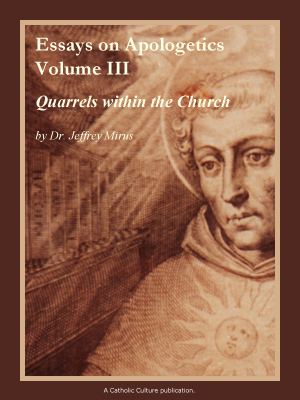Piam et Constantem
by Holy Office
{3366} The reverent, unbroken practice of burying the bodies of the faithful departed is something the Church has always taken pains to encourage. It has surrounded the practice with rites suited to bring out more clearly the symbolic and religious significance of burial and has threatened with penalties those who might attack the sound practice. The Church has especially employed such sanctions in the face of hate-inspired assaults against Christian practices and traditions by those who, imbued with the animosity of their secret societies, sought to replace burial by cremation. This practice was meant to be a symbol of their antagonistic denial of Christian dogma, above all of the resurrection of the dead and the immortality of the soul.
Such an intent clearly was subjective, belonging to the mind of the proponents of cremation, not something objective, inherent in the meaning of cremation itself. Cremation does not affect the soul nor prevent God's omnipotence from restoring the body; neither, then, does it in itself include an objective denial of the dogmas mentioned.
The issue is not therefore an intrinsically evil act, opposed per se to the Christian religion. This has always been the thinking of the Church: in certain situations where it was or is clear that there is an upright motive for cremation, based on serious reasons, especially of public order, the Church did not and does not object to it.
There has been a change for the better in attitudes and in recent years more frequent and clearer situations impeding the practice of burial have developed. Consequently, the Holy See is receiving repeated requests for a relaxation of church disciples relative to cremation. The procedure is clearly being advocated today, not out of hatred of the Church or Christian customs, but rather for reasons of health, economics, or other reasons involving private or public order.
It is the decision of the Church to accede to the requests received, out of concern primarily for the spiritual well-being of the faithful, but also out of its awareness of other pressures. The Church therefore establishes the following.
{3367} 1. All necessary measures must be taken to preserve the practice of reverently burying the faithful departed. Accordingly, through proper instruction and persuasion Ordinaries are to ensure that the faithful refrain from cremation and not discontinue the practice of burial except when forced to do so by necessity. For the Church has always maintained the practice of burial and consecrated it through liturgical rites.
{3368} 2. It has seemed the wiser course, however, to relax somewhat the prescriptions of canon law touching on cremation, for two reasons. One is so that difficulties arising from contemporary circumstances may not be unduly increased; the other, so that the need for dispensation from the pertinent laws may not arise too often. Accordingly, the stipulations of CIC can. 1203, par. 2 (on carrying out a person's will to be cremated) and of can. 1240, par. 1, no. 5 (on the denial of ecclesiastical burial to a person who has left such a directive) no longer have universal binding force, but only in those cases in which it is clear that the reason for choosing cremation was either a denial of Christian dogmas, the animosity of a secret society, or hatred of the Catholic religion and the Church.
{3369} 3. From this it follows that the sacraments or public prayers are not to be refused to those who have chosen cremation unless there is evidence that their choice was made on the basis of the anti-Christian motives just listed.
{3370} 4. The devout attitude of the faithful toward the ecclesiastical tradition must be kept from being harmed and the Church's adverse attitude toward cremation must be clearly evident. Therefore the rites of ecclesiastical burial and the ensuing suffrages may never be carried out at the place of cremation itself, not even simply to accompany the body as it is being brought there.
The cardinals in charge of safeguarding matters of faith and morals reviewed this Instruction in a plenary meeting on 8 May 1963. Pope Paul VI at an audience granted to the Cardinal Secretary of the Holy Office on 5 July 1963 has agreed to approve it.
© Libreria Editrice Vaticana 2016
This item 11422 digitally provided courtesy of CatholicCulture.org






